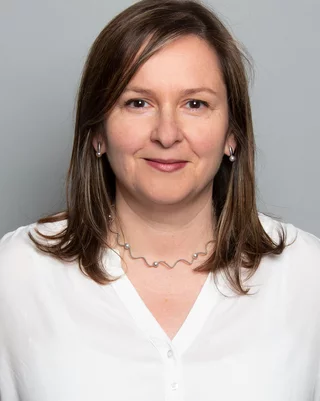Interview with Sabine Mayer
Ms. Mayer, You have been Head of the Division for Radiation Safety and Security since the beginning of the year and hence responsible for safety at PSI from its in-house fire brigade over occupational health and safety to radiological monitoring.
Yes, there are indeed several sides to safety at the Paul Scherrer Institute. We shape safety policy on all levels. We are responsible for access controls, surveillance of the premises, the upholding of statutory radiation safety, compliance with statutory provisions in the areas of fire protection and occupational health and safety. In a nutshell, ASI is a support and information service on all aspects of safety and security. This calls for extensive, multidisciplinary knowledge.
The experts in your Division are also in demand outside PSI.
Radiation safety is a broad area and therefore very interesting. I particularly appreciate the rewarding exchange with the authorities on the specialist level. They need our know-how; our proposals are taken on board. The Federal Office of Public Health (FOPH), the Swiss Federal Nuclear Safety Inspectorate (ENSI) and the Federal Institute of Metrology (METAS) rely on our pool of experts. We help shape safety policy in Switzerland. It is very interesting to be part of the bodies which map out the broad guidelines.
You are not just responsible for safety at PSI; you also provide services for the population at large.
We have, for example, a stand-by service for radiation safety. The National Emergency Operations Centre (NAZ) can call on our staff members at any time for an outside assignment. If there is an incident with elevated radiation levels, our trained staff can undertake the measurements and initiate the corresponding measures. For instance we are called out to Zürich-Kloten Airport when a container with radioactive contents has been damaged during transport. But that only happens very rarely.
Do you get enquiries from the general public?
We had a few right after Fukushima. If people really have good reasons for being concerned and can come to PSI, we help them without a lot of red tape. Some companies asked us to examine the goods of their Japanese suppliers. In other cases we lent out our measurement devices because, at that time, they were difficult to obtain on the market.

Sabine Mayer (38) graduated in Vienna from the Higher Technical Institute (HTL) in Biomedical Technology. She studied Technical Physics specialising in radiation physics at the Vienna University of Technology. She already wrote her thesis at CERN on a radiation safety research topic. She then spent two years as a Fellow at CERN. From there she applied for a physicist’s position in radiation metrology. This is how she came to the PSI Division for Radiation Safety and Security in October 2005. She took over as Head of Division on 1 January 2013. She is a member of the Swiss Federal Commission for Radiation Protection and Monitoring of Radioactivity, KSR. Mrs Mayer is married and has a one-year-old son. In her limited leisure time she likes to jog and play tennis.
To what extent were ASI and its services involved after Fukushima?
PSI had a lot of visitors. Returning embassy staff and people from relief agencies who had gone to help in Japan came for whole-body counting. With the whole-body counter we can examine whether someone has absorbed radioactive substances into his body. Furthermore, our staff members were on site at Zürich-Kloten Airport to instruct the relief agency staff in using the measurement equipment. We also helped the airport staff monitoring luggage for radiation. One staff member went to Japan and trained people in how to use the measurement devices.
You mentioned the whole-body counter. In a basement the “person-like phantom” IGOR is waiting to be used. A visit there reportedly isn’t very popular.
Yes, but that’s not IGOR’s fault. He is actually a quite pleasant chap made of polyethylene. It has got more to do with his “workplace”. We use IGOR to calibrate the whole-body counter. With this device around 270 people are examined every year, for instance people who were on site in Fukushima as well as employees from nuclear power plants or radionuclide laboratories. The measurement just takes seven minutes but it is done in a small iron-clad measurement chamber. We do everything we can to make a stay there as pleasant as possible. We’ve put up beach posters and there’s background music. Particularly after Fukushima we were able, thanks to IGOR, to calm the fears of many people and inform them that they had not absorbed any radioactive substances.
What happens when you find something?
We inform the supervisory authorities and, if the employee works for an external company, the licence holder. Very rarely only do we have such cases.. For example, we did not record any levels that were higher than the very strict legal limits for anyone who had actually been in Fukushima.
How do you explain the measurement values to lay people?
We often have to put this into perspective, place the values in context and explain that low radiation exposure is unavoidable given the natural radiation. In this context, you need to know that natural terrestrial radiation depends on the location. In the Alps it may be twice as high as in the Mittelland region of Switzerland. In the mountains cosmic radiation is of greater importance as it increases with altitude. Radon accounts for most of the radiation from natural sources. It is mainly found in lower-lying areas because it escapes from soil and rock.
Cue natural radioactivity: PSI has a calibration chamber for radon measurement devices.
We calibrate the devices of the official radon measurement offices in Switzerland at regular intervals. But we also undertake verification on behalf of METAS. As an accredited calibration service we likewise calibrate many other types of radiation measurement devices. This is interesting because this is physics in practice.

